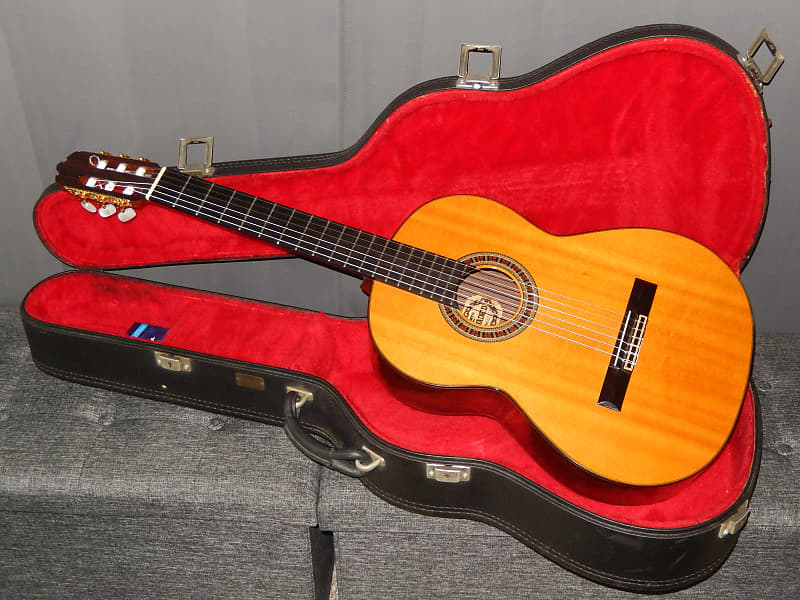

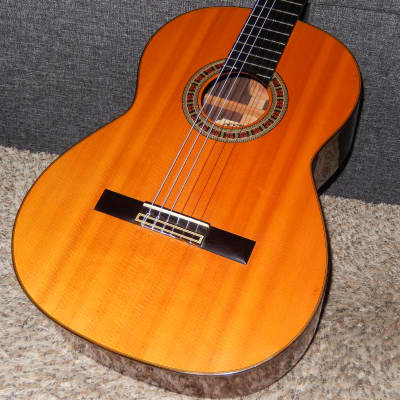
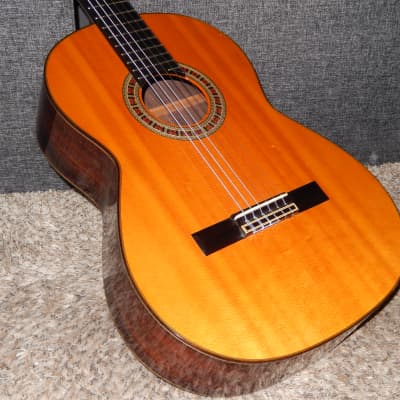
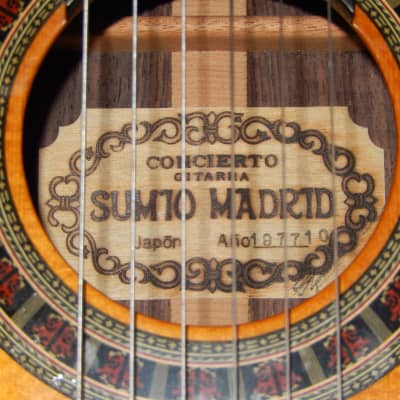
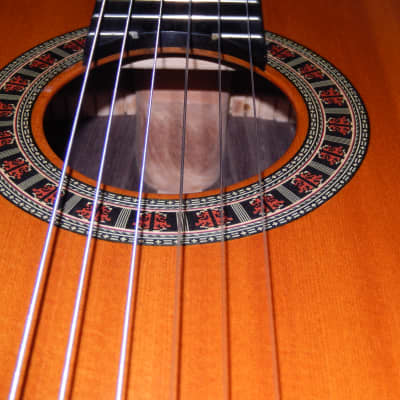
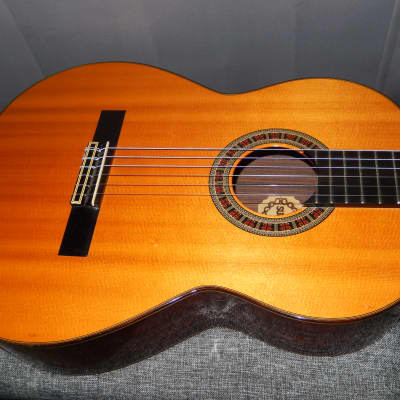
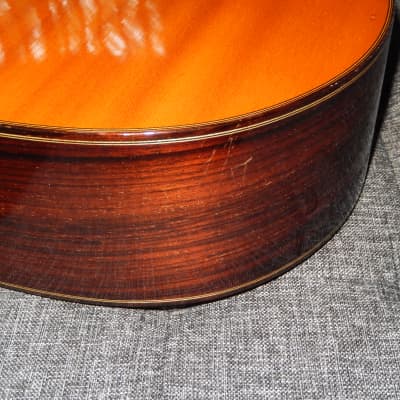
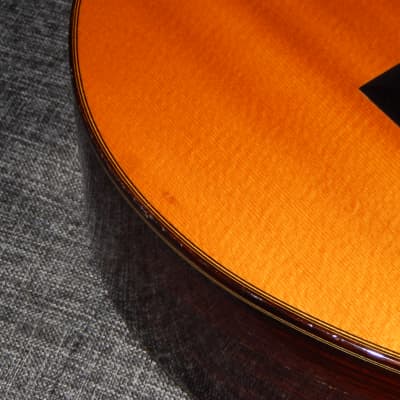
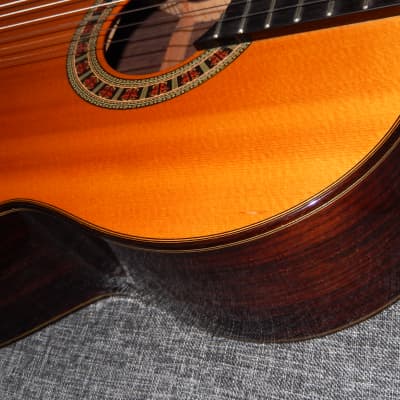
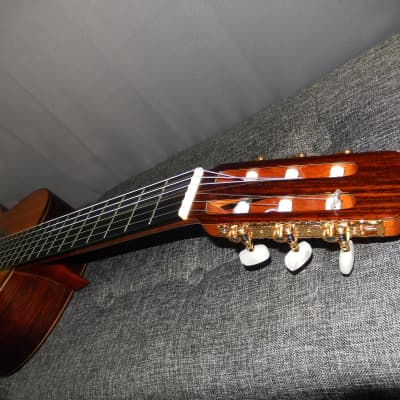
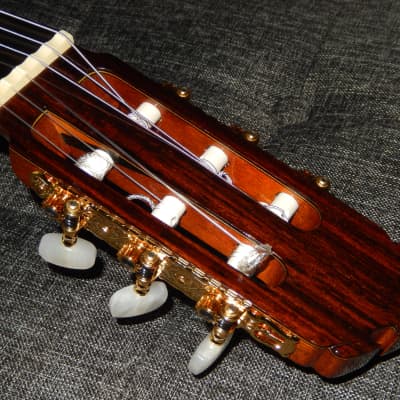
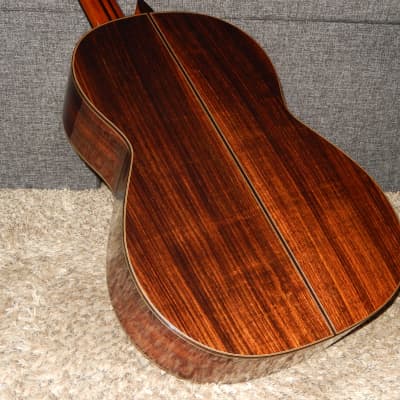
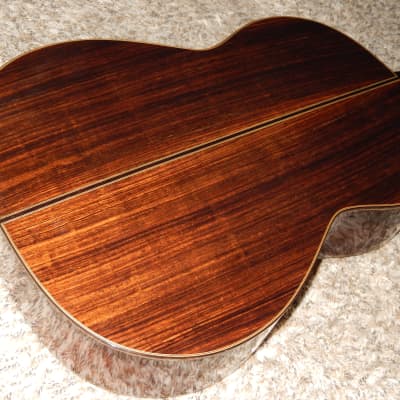
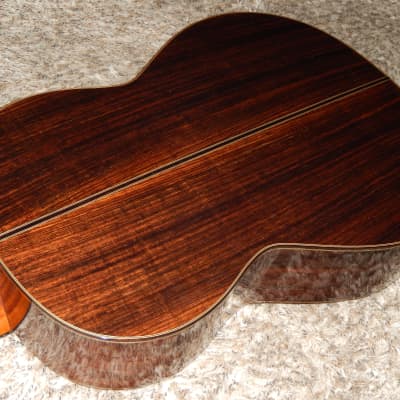
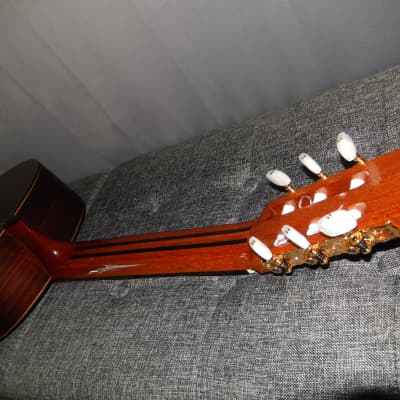
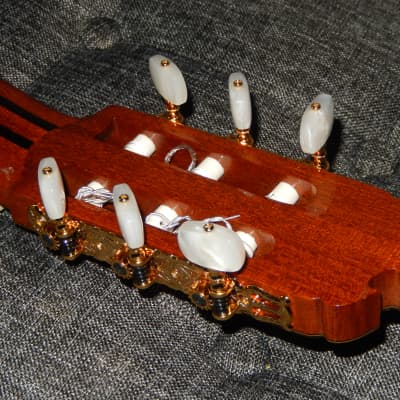
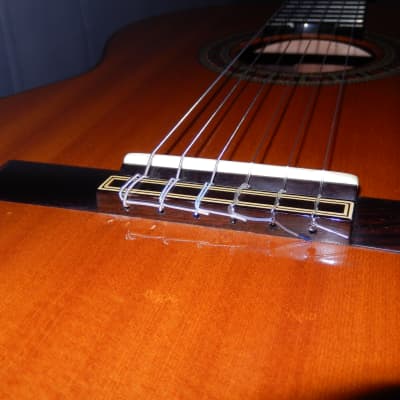
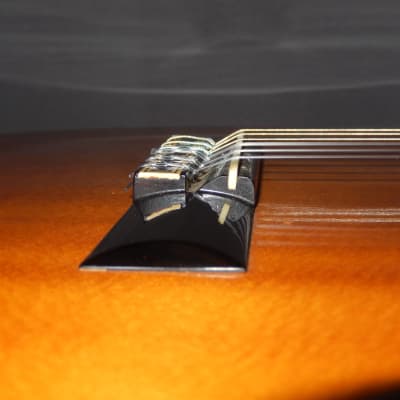
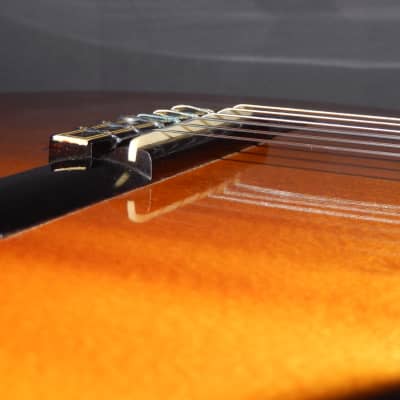
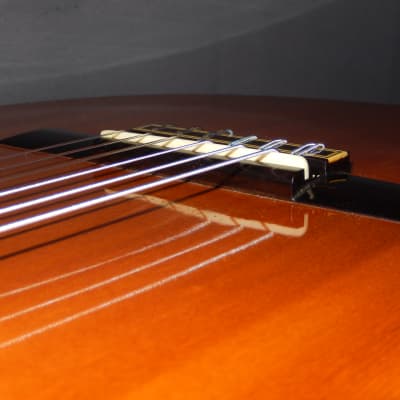
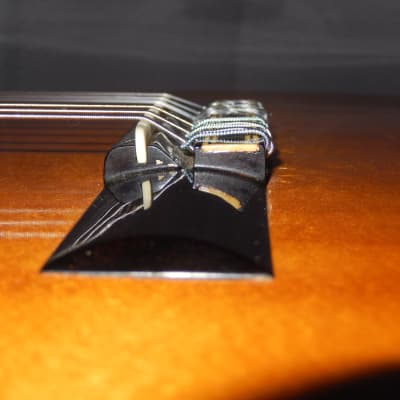
Several hundred guitars I have sold in the past are presented at Facebook.com/Victors.Guitar.Library.
Sumio Kurosawa “Sumio Madrid” 10 1977
This terrific guitar was made in 1977 by Japanese elite luthier Sumio Kurosawa.
Sumio Kurosawa studied guitar making under his uncle, Tsunesaburo from 1958 and moved to Spain in 1963. There he studied with Victoriano Aguado for a couple years and returned to Japan. He established his own workshop in early 1970s.
In late 1970s Sumio was selling guitars under a nick name “Sumio Madrid” yet with his hand signature on the label. Thanks to these “Sumio Madrid” guitars (models: 10, 15 and 20) he soon became one of most regarded luthiers in Japan. By early 1990s he was already a permanent member of Japanese Luthier’s Elite. He could price his guitars at the same level as other most prominent Japanese classical guitar makers of that era: Masaru Kohno, Sakazo Nakade, Toshihiko Nakade and Yamaha’s Hideyuki Ezaki.
Yet in 1977 Sumio still had to price his guitars at very moderate level. While being priced the same 100 000 yen, this guitar is far superior to Masaru Kohno’s model 10 or Yamaha GC10.
In general, Sumio’s guitars are sweeter, and far more lyrical. This magical lyricism is combined with great volume and response, great richness, with cello-like basses and piano-like trebles, yet also with great level of transparency, superb note clarity & separation, and truly amazing sustain.
By 1982, the same specification and class guitar, would be labelled as model 15 and by mid 1990s as model 20. By 2010 the same class Sumio’s signature model was priced 650 000 yen. Sumio doesn’t make guitars anymore. Sumio’s son Tetsuru is now the head of Kurosawa workshop.
As of today, if you wanted to order a same class brand new guitar made with 50+ years old woods and made by leading Japanese luthier it would cost you at least $6000. If you would like to place the same order with a Japanese elite luthier, the price would be at least $8000. Naturally Spanish luthiers are far pricier.
This guitar remains in overall “excellent for its age”, even though its body bears few very minor cosmetic flaws, with most "conspicuous" being: 2 small dents on the top, few very light scratches on its side (lower right bout) and light attritions the side bindings (lower right bout). Close up pictures 7-9 show the "damages" greatly exaggerated.
Most importantly guitar doesn’t have any structural problems, while its straight neck, fingerboard and frets all remain in excellent condition.
Because original tuners were not working properly anymore, they were replaced with new Gotoh set.
Specifications:
Top: Very High Grade Solid Spruce/ Ramirez style transverse bracing/ cashew lacquer
Back & Sides: Solid Indian Rosewood/ Cashew lacquer
Neck: Mahogany with double Ebony Inserts
Fingerboard: Ebony
Scale: 650mm
Nut width: 52.00 mm
Action is set (by the maker) to 4.00 mm under E6 and 3.00 mm under E1 with plenty of extra room on the saddle (about 3.20mm room on the E6 string side and about 2.50mm on the E1 side).
Guitar will be shipped in used hard shell case.
When contemporary Japanese luthiers are using 40+ years old soundboards to make “all solid woods” guitar it is priced at least $5000USD. Guitars with artificially aged (“baked”) soundboards are priced at least $4500USD. Solid top models with 40+ years old soundboards are priced at least $3500USD. American, Australian and European luthiers usually charge 50% more.
It is a matter of basic education (not beliefs) to realize that 50+ years old soundboard of this guitar alone is worth $2500USD.
Real Value of Japanese Vintage Guitars
The key to understand value of vintage Japanese guitars is to acknowledge galloping price inflation (devaluation of Japanese yen) during 1960s & 1970s. This inflation slowed down in 1980s.
During 1960s and most of 1970s model numbers of Japanese guitars were strictly interconnected with their prices in Japanese yen. By early 1980s and during following decades model numbers were no longer strictly associated with their prices. Some Japanese guitar makers introduced model names instead of model numbers. Others were still using model numbers with addition of letters and/or other symbols.
It is then important to understand that two Yamaha GC10 guitars made 10 years apart are two instruments of totally different class. The same applies to any other Japanese maker/brand.
The logical way to estimate the true class of any given Japanese made instrument is to compare its price with the average annual salary of wage workers in Japanese private sectors. This salary was: 450 600 yen in 1965 - 825 900 yen in 1970 - 1 868 300 yen in 1975 - 2 689 000 yen in 1980 - 3 163 000 yen in 1985 - 3 761 000 yen in 1990 - 4 107 000 yen in 1995 - 4 082 000 yen in 2000.
Any guitar priced 100 000 yen in 1970 (labelled as No10 or No100) would be priced 200 000 yen in 1975 (relabeled to No20, No200 or 2000), 300 000 yen in 1977 (labelled as No3, No30 or 3000) and 500 000 yen by 1985 (labelled as No50 or 5000).
Starting in 1977 Masaru Kohno introduced his new models No40 priced 400 000 yen and No50 priced 500 000 yen. By early 1980s Kohno started using model names instead of numbers and was steadily raising their prices without changing model labeling. His very top model 50 became model “Special”, and a decade later it became model “Maestro”. Naturally, all other Japanese guitar makers were doing similar pricing (labelling) upgrades.
Knowing all of that, you can bet on that Masaru Kohno No50 made in 1982 is practically the same grade instrument as Kohno No20 made in 1972, or Kohno no 30 made in 1975.
In early 1970s the lowest Ryoji Matsuoka (all plywood) model was 10, followed by (solid top) models 15, 20, 25, 30, 40, 50, 60, 80 and (all solid woods) models 100 and 150. Models 50, 60 and 80 were made with non-solid figured Brazilian Rosewood (double) back and sides and top model 150 was the only one made with solid figured Brazilian Rosewood b/s.
In 1980 the lowest Matsuoka model was (all plywood) 20, followed by (solid top) models 30,40,50, 60 and all solid woods models 80,100,150 and 200. By 1990 the lowest Matsuoka model was M40 and the highest was M300. By 2010 the lowest Matsuoka model was M50 and the top model was M270.
You can bet that Ryoji Matsuoka model 50 from 1980 is of the same grade as model M100 from 2000, model 100 from 1980 is of the same grade as model M150 from 2000, model 150 from 1980 is of the same grade as M200 from 2000 and model 200 from 1980 is of the same grade as model M300 from 2000.
It is important to mention that if modern era luthiers are using 40+ years old woods to make an “all solid” wood classical guitar, its price is minimum $8000.
All vintage guitars made with Brazilian Rosewood are especially precious, including those made straight grain varieties and those with non-solid b/s.
Because response and tonal properties of Spruce soundboards are improving over time, long seasoned Spruces are far more precious than long seasoned Cedars.
It is not very difficult to find out what are current prices of such guitars made by world’s leading luthiers.
Important message for Australian buyers:
USPS International Priority Mail packages destined for Australia have quite restricted size (max. length is 42” and max. length + girth is 97”). For these reasons I must use the case that is no longer than 41” and therefore it may be different than the one you see on the pictures. You should ask me for any other details prior to making a purchase.
Reverb Buyer Protection
Reverb has your back if your item is lost, damaged, or doesn't match its description. Simply report any issues within 7 days and we'll help you get a full refund.Learn more about Reverb Buyer Protection.
| Listed | 2 years ago |
| Condition | Very Good (Used) Very Good items may show a few slight marks or scratches but are fully functional and in overall great shape.Learn more |
| Brand | |
| Model |
|
| Finish |
|
| Categories | |
| Year |
|
| Made In |
|
| Body Shape |
|
